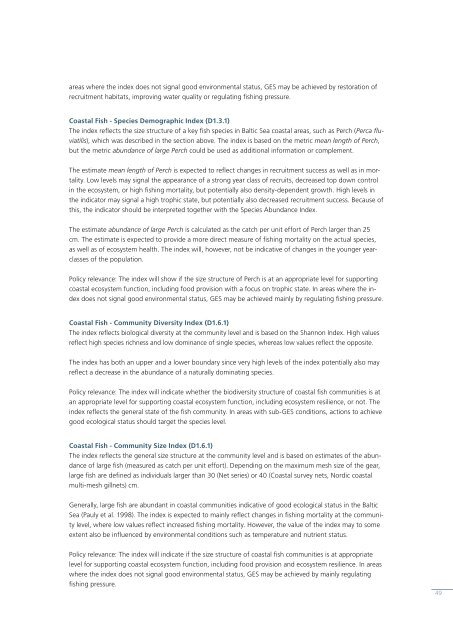Interim report of the HELCOM CORESET project
Interim report of the HELCOM CORESET project
Interim report of the HELCOM CORESET project
You also want an ePaper? Increase the reach of your titles
YUMPU automatically turns print PDFs into web optimized ePapers that Google loves.
areas where <strong>the</strong> index does not signal good environmental status, GES may be achieved by restoration <strong>of</strong><br />
recruitment habitats, improving water quality or regulating fi shing pressure.<br />
Coastal Fish - Species Demographic Index (D1.3.1)<br />
The index refl ects <strong>the</strong> size structure <strong>of</strong> a key fi sh species in Baltic Sea coastal areas, such as Perch (Perca fl uviatilis),<br />
which was described in <strong>the</strong> section above. The index is based on <strong>the</strong> metric mean length <strong>of</strong> Perch,<br />
but <strong>the</strong> metric abundance <strong>of</strong> large Perch could be used as additional information or complement.<br />
The estimate mean length <strong>of</strong> Perch is expected to refl ect changes in recruitment success as well as in mortality.<br />
Low levels may signal <strong>the</strong> appearance <strong>of</strong> a strong year class <strong>of</strong> recruits, decreased top down control<br />
in <strong>the</strong> ecosystem, or high fi shing mortality, but potentially also density-dependent growth. High levels in<br />
<strong>the</strong> indicator may signal a high trophic state, but potentially also decreased recruitment success. Because <strong>of</strong><br />
this, <strong>the</strong> indicator should be interpreted toge<strong>the</strong>r with <strong>the</strong> Species Abundance Index.<br />
The estimate abundance <strong>of</strong> large Perch is calculated as <strong>the</strong> catch per unit effort <strong>of</strong> Perch larger than 25<br />
cm. The estimate is expected to provide a more direct measure <strong>of</strong> fi shing mortality on <strong>the</strong> actual species,<br />
as well as <strong>of</strong> ecosystem health. The index will, however, not be indicative <strong>of</strong> changes in <strong>the</strong> younger yearclasses<br />
<strong>of</strong> <strong>the</strong> population.<br />
Policy relevance: The index will show if <strong>the</strong> size structure <strong>of</strong> Perch is at an appropriate level for supporting<br />
coastal ecosystem function, including food provision with a focus on trophic state. In areas where <strong>the</strong> index<br />
does not signal good environmental status, GES may be achieved mainly by regulating fi shing pressure.<br />
Coastal Fish - Community Diversity Index (D1.6.1)<br />
The index refl ects biological diversity at <strong>the</strong> community level and is based on <strong>the</strong> Shannon Index. High values<br />
refl ect high species richness and low dominance <strong>of</strong> single species, whereas low values refl ect <strong>the</strong> opposite.<br />
The index has both an upper and a lower boundary since very high levels <strong>of</strong> <strong>the</strong> index potentially also may<br />
refl ect a decrease in <strong>the</strong> abundance <strong>of</strong> a naturally dominating species.<br />
Policy relevance: The index will indicate whe<strong>the</strong>r <strong>the</strong> biodiversity structure <strong>of</strong> coastal fi sh communities is at<br />
an appropriate level for supporting coastal ecosystem function, including ecosystem resilience, or not. The<br />
index refl ects <strong>the</strong> general state <strong>of</strong> <strong>the</strong> fi sh community. In areas with sub-GES conditions, actions to achieve<br />
good ecological status should target <strong>the</strong> species level.<br />
Coastal Fish - Community Size Index (D1.6.1)<br />
The index refl ects <strong>the</strong> general size structure at <strong>the</strong> community level and is based on estimates <strong>of</strong> <strong>the</strong> abundance<br />
<strong>of</strong> large fi sh (measured as catch per unit effort). Depending on <strong>the</strong> maximum mesh size <strong>of</strong> <strong>the</strong> gear,<br />
large fi sh are defi ned as individuals larger than 30 (Net series) or 40 (Coastal survey nets, Nordic coastal<br />
multi-mesh gillnets) cm.<br />
Generally, large fi sh are abundant in coastal communities indicative <strong>of</strong> good ecological status in <strong>the</strong> Baltic<br />
Sea (Pauly et al. 1998). The index is expected to mainly refl ect changes in fi shing mortality at <strong>the</strong> community<br />
level, where low values refl ect increased fi shing mortality. However, <strong>the</strong> value <strong>of</strong> <strong>the</strong> index may to some<br />
extent also be infl uenced by environmental conditions such as temperature and nutrient status.<br />
Policy relevance: The index will indicate if <strong>the</strong> size structure <strong>of</strong> coastal fi sh communities is at appropriate<br />
level for supporting coastal ecosystem function, including food provision and ecosystem resilience. In areas<br />
where <strong>the</strong> index does not signal good environmental status, GES may be achieved by mainly regulating<br />
fi shing pressure.<br />
49













